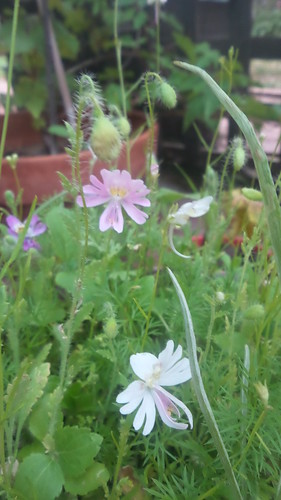Mr Fothergill's Cottage Garden Mix
poppies in the background and ... I'm not sure in the foreground ...
It's been a billion years since I posted here and it's a similar thing (although not quite such an extended hiatus) over at Best Beauty Buys. I've decided to combine both here into much more of a lifestyle blog.
Actually, it will be more of a diary than 'lifestyle blog'. You are unlikely to find beautifully composed and lit photos of some magical life I'm living - though I'm happy to post a photo of our sitting room floor covered in Lego if anyone's interested.
Anyway, I am finally getting some control over our garden. Some. Not a lot.
As I've been doing a lot of garden writing for a magazine I now count gardening time as professional development. Interviewing people (and seeing some amazing gardens) has also given me a ton of inspiration. While many of the gardens have been very structural and designed, many others have been much more organic which gives me some hope.
Over time I appear to have amassed quite a collection of seeds so I'm busy using them up as best I can. Many of them are past their 'use by' date which is fine - I'm using them anyway and seeing what happens.
I received a pack of Mr Fothergill's Cottage Garden Mix a couple of years ago now but have only just opened it. We've got quite a few pots around so I filled one of the more attractive ones with potting mix and dumped a load of the seeds in it and sat back to see what would happen.
As you can see, I sowed quite densely and I haven't bothered thinning out but I think that this has worked well. I emailed Mr Fothergill's to find out what is typically in the mix to help identify the flowers. After all, if I particularly like something I might want to source it again - and maybe even work out a mix of my personal favourites. They quickly came back to me with the usual contents, which includes the following: matthiola incana (stock), papaver rhoeas (poppy), ageratum houstonianum, antirrhinum majus maximum tetraploid (snapdragon), centaurea cyanus (cornflower), cosmos bipinnatus, linaria maroccana and nigella damascene.
The linaria maroccana is quite tall and spindly. It is native to Morocco and it's also known as Moroccan toadflax. Planted densely it might look might striking but I think in this mix it looks a bit anaemic.
The poppies (papaver rhoeas) are lovely though and I'm now getting some other flowers starting to appear.
This mix was insanely easy to grow - in a pot it was just a case of actually watering it. Plants magically appeared and flowers ensued. With enough care and in the right spot, it's probably much the same in an actual garden bed - providing you don't have to fend off snails. What I enjoy about pots is that I can move them around so that they avoid harsh sun on stinking hot days (the mercury's already cracked 40 and it's not yet summer!) and also give them pride of place when they start to flower.
As flowering takes 8-14 weeks to kick in (and, from my hazy recollection of when I actually planted these, that sounds about right) if you get your timing right you could also plant in cute pots and use as either presents or decoration for special events.



0 Comments:
Post a Comment
Subscribe to Post Comments [Atom]
<< Home